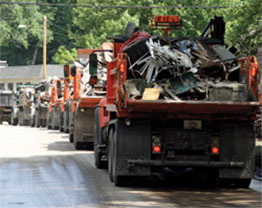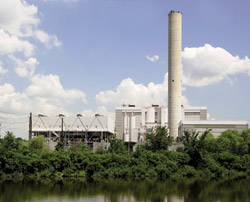
Waste-to-Energy
The financial and environmental costs associated with the traditional waste management process of collecting waste for deposit in a landfill are significant. Hauling waste to a landfill is expensive, produces vehicle emissions that degrade air quality and contributes to traffic congestion.
 Once at the landfill, the waste decomposes, releasing greenhouse gases. Utilizing available and proven technology to recover energy from organic waste avoids many of these costs. Processed properly, organic waste becomes a resource and a waste-to-energy (WTE) power plant becomes a clean, reliable source of renewable energy.
Once at the landfill, the waste decomposes, releasing greenhouse gases. Utilizing available and proven technology to recover energy from organic waste avoids many of these costs. Processed properly, organic waste becomes a resource and a waste-to-energy (WTE) power plant becomes a clean, reliable source of renewable energy.
A WTE project is more than forcing a “one-size-fits-all” technology onto a community. There are considerations beyond the technology that are equally important; these projects often represent a dramatic shift in city or regional waste management and energy planning. NuEnergy’s first step in project development is coordinating with the local community and conducting a feasibility study to identify local conditions, including waste stream characteristics, other available renewable energy resources and unique local issues that need to be addressed. The result will be a project that delivers the best value to the community.
WTE Basics
Organic waste deposited in a landfill decomposes over time, releasing a mixture of greenhouse gases into the atmosphere. Gasification controls and accelerates the natural decomposition process to create synthesis gas (syngas), which is used to generate power. This technology is not new; in the mid-1800’s many large cities used gasification to produce the gas used for street lighting.
All technologies that convert waste-to-energy involve the same basic steps.
- Waste pre-processing: Waste is delivered to the facility and processed for the delivery to the gasifier.
- Conveyance: Systems will generally include some sort of conveyor to move the pre- processed waste to the gasifier.Gasifier: All technologies put the waste into a chamber that is essentially an organic waste pressure cooker. While gasifiers are all different in some way, using multiple chambers or processing waste at differing combinations of time, temperature and pressure, all essentially perform the same function – the conversion of organic waste into syngas. Gasification is not incineration; the oxygen content is controlled during the process to ensure that the waste is never combusted or burned.
- Steam & Power Creation: Syngas moves from the gasifier to a boiler where the syngas is combusted, with heat creating steam that powers turbines to generate power.
- Treatment of Flue Gas: Any flue gas is treated so that system emissions meet all applicable air quality systems.

There is off the shelf, proven equipment to handle each of the steps described above. Because gasifier performance is dependent upon the facility feedstock, technology selection cannot be determined until a number of project parameters are established.
The facility design developed by the NuEnergy project team will incorporate the most appropriate, proven, cost effective technology solution available and capable of providing the maximum benefits to the local community and the global environment.